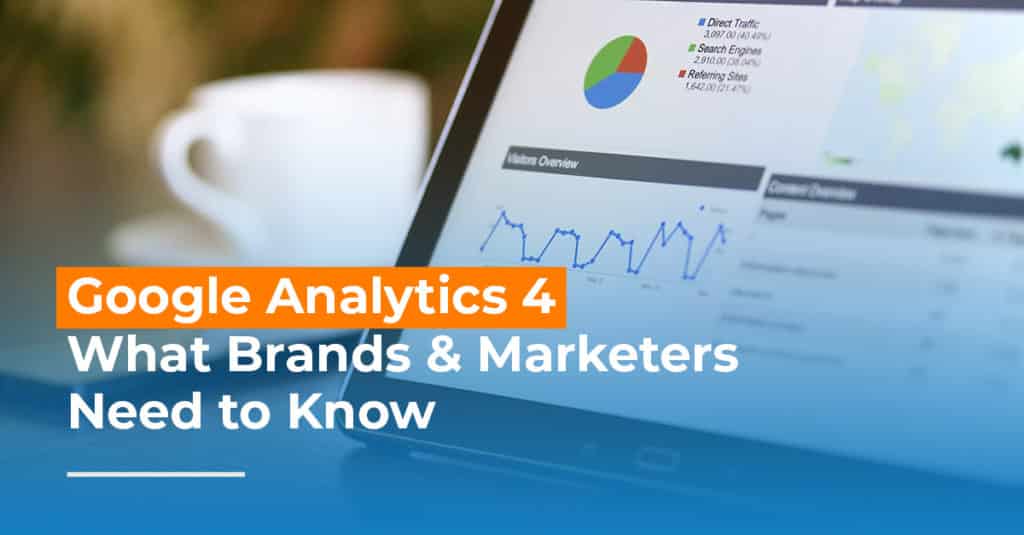Google Analytics 4: What Brands & Marketers Need to Know
Google is set to take the next step in enhancing data and analytics, with Google Analytics 4 soon to replace Universal Analytics entirely. Initially released in Beta form in 2019, Google Analytics 4 is a completely new version of the platform, representing a more advanced and event-driven data model.
Google has announced that Google Analytics 4 (GA4) will replace Universal Analytics from July 1, 2023. Universal Analytics reports will remain accessible for a period of time, however after this date new data will only flow into Google Analytics 4 properties.
What does Google Analytics 4 mean for businesses?
Google Analytics 4 represents a shift away from a cookie dependent generation of online measurement anchored in desktop web, to a period that puts user privacy at the forefront. Brands and businesses need modern analytics to negate current and future challenges, and GA4 is designed to close some of the gaps posed by today’s biggest data challenges.
GA4 is the next generation of analytics, designed to help close the gaps posed by the shifting digital landscape because:
1. It is built with the future in mind.
GA4 is a lot more streamlined than its predecessor. The platform is designed for tracking multiple experiences, and has the capability to adapt to new technology and future advancements.
2. It represents more robust tracking.
Over the past few years, we have seen more people choosing to opt out of trackable experiences as we shift towards a privacy-first world. In line with this, GA4 has been created to place less reliance on tracking via cookies.
3. GA4 uses enhanced AI for deeper insights.
GA4 uses machine learning algorithms to monitor the process to conversion, and provide predictive insights on the future behaviour of your customer.
What benefits does Google Analytics 4 offer?
1. Better visibility across user touchpoints.
Brands will now have the opportunity to access a more holistic view of their digital performance. GA4 provides a more complete view of the customer journey, rather than separating data by platform or into independent sessions.
GA4 also allows for the unification of data across web and applications, pulling information (such as sales figures) into a centralised report. This is good news for merchants who blend web and app experiences across their customer journey, as they will now be able to access a comprehensive single source of truth.
2. New and improved attribution.
The GA4 rollout will make data-driven attribution the new normal. Google’s attribution algorithm will distribute conversion credit across user touchpoints, providing improved insight into which marketing activities drive conversions.
The GA4 attribution model is grouped into:
- Cross-channel rules-based model
- Ads-preferred rules-based model
- Data-driven attribution model
- Reporting attribution model
3. Prioritising behavioural segmentation.
GA4 prioritises tracking behavioural data over demographic segmentation. This change will give brands and marketers access to more intelligent insight into website users and a better understanding of their customer journey.
As we move towards a privacy-first web, this shift will help businesses remain in line with compliance requirements.
4. Predictive analytics.
GA4 will use machine learning to surface deep insights into predicted user behaviour across three key metrics:
- Purchase profitability – the probability that users who have been active in the last 28 days and will make a purchase in the next 7 days
- Churn profitability – the probability that users who have visited your website in the last 7 days will not be active in the next week
- Predicted revenue – revenue expected from all purchase event in the next 28 days from active website users over the past 28 days
In order to harness the power of predictive insights, GA4 has some data prerequisites. Brands need to have at least 1000 users who have triggered the event, and 1000 users who have not.
5. Custom reporting.
Compared to the 20 static events from UA (such as page views, transactions, etc.), with GA4, brands can track 50 events that can be fully customised. These form just one of the four event categories available on GA4:
- Automatically collected event
- Enhanced measurement events
- Recommended events
- Custom events
GA4’s reduction of default reports and uptake of custom events allows brands to customise reporting across key business objectives. There are also a number of reports available out of the box, meaning brands don’t need to jump straight into full customisation, these include user lifetime, acquisition, Ecommerce, cohort exploration and more.
6. Expanded integrations.
GA4 enables expanded integrations with other Google products, including Search Ads 360.
This will power more robust cross-channel reporting, including attribution for search ads in Model Comparison Reports and Conversion Path Reports. Additionally, brands can access user, session and conversion metrics across different dimensions of source/medium, campaign and channel.
Here’s a full list of current GA4 integrations:
- Google Ads
- BigQuery Export
- Display & Video 360
- Google Merchant Centre
- Firebase
- Google Ad Manager
- Google Optimise
- Salesforce Marketing Cloud
- Search Console
- Analytics Search Ads 36
What are GA4’s limitations?
As with any new development, GA4 comes with some limitations.
1. Some reportable metrics may change.
A few of the metrics available in UA will not have equivalents in the new GA4, but by default brands should be able to configure something very similar. As a result, this will mean there are some areas of reports that cannot be accurately reported year-on-year and will need to be adapted accordingly.
2. No data migration.
Unfortunately, there is no simple way to migrate data from Universal Analytics to GA4. We are hopeful that Google will introduce a process for data migration, however currently brands and marketers will need to find their own solution.
Currently we are suggesting brands begin looking at alternatives (such as Google’s cloud data warehouse ‘BigQuery’).
3. UA properties will be deleted.
Google plans to stop collecting UA data from the 1st July 2023 and subsequently delete UA properties six months after that sunset.
GA4 is live and accessible now, which is why we are encouraging all brands to be fully set up and running as soon as possible. This will enable brands to capture a full year of comparative data ahead of UA’s disappearance.
GA4 Migration FAQs
Here are the key information brands need to know as they prepare to migrate to GA4.
1. How do I set up GA4 tracking?
Install the GA4 tracking code as soon as possible to gain the most amount of data you can before UA data is deleted. You can also use Google Tag Manager (GTM) to set up GA4 tracking. This is highly recommended as they were both designed to be used in-sync with one another.
2. When will current tracking of standard UA properties stop?
This will happen on the 1st July 2023 and the processing of UA 360 properties will end three months later, in October 2023.
3. How long will UA data be available for?
After the 1st July 2023 all new tracking will be done under GA4 properties, although users will have access to previously processed UA data for at least six months.
Google is yet to announce exactly when, but at some point beyond this, UA data will no longer be available to report on.
4. When should I switch to GA4?
We are recommending that all brands make the switch to GA4 as soon as possible, in order to build the necessary historical data before UA stops processing new hits.
Waiting until closer to the UA sunset date to make the switch to GA4 is a big risk. It will mean there’s no historical data available within the new GA4 property, which poses problems when it comes to conducting year-on-year analysis and creating audiences, for example.
5. Can you run UA and GA4 on the same website?
Yes! This is the recommended approach as the data model and reporting can take some getting used to.
Level up your digital marketing with enhanced Google Analytics 4
If you’d like to know more about what GA4 means for your brand, get in touch with a member of the Reload Media team today.





















